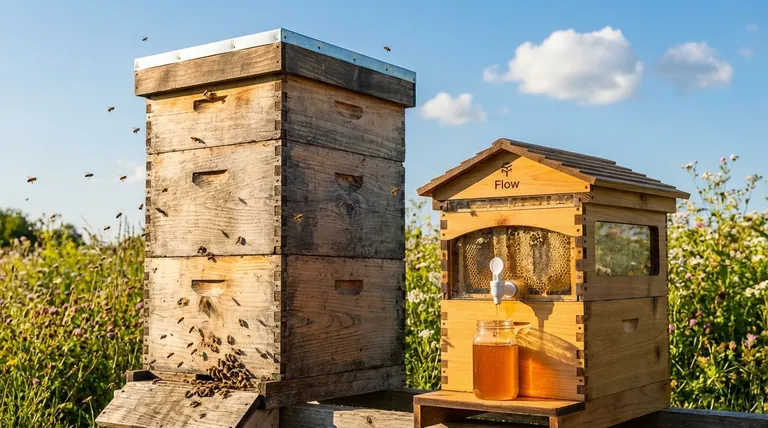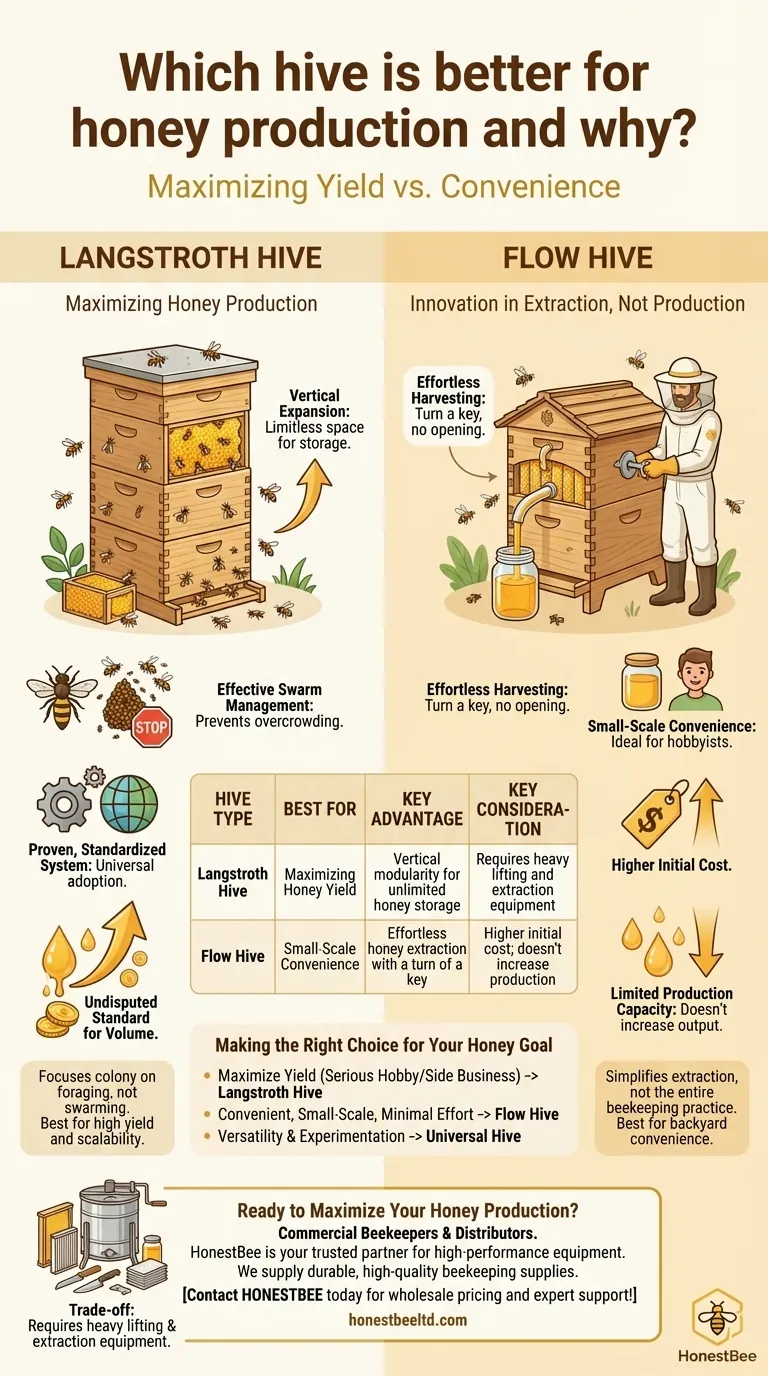For maximizing honey production, the Langstroth hive is the undisputed industry standard. Its design is fundamentally centered on creating a large, productive colony with ample space for honey storage. This modular expandability directly translates to higher honey yields by keeping the colony focused on foraging and storing nectar rather than swarming.
The best hive for honey production is not determined by how the honey is extracted, but by how effectively the hive supports a massive, healthy colony. The Langstroth hive excels at enabling colony growth and providing limitless storage space, making it the top choice for volume, while other hives prioritize harvesting convenience for smaller-scale operations.

Why the Langstroth Hive Dominates Honey Production
The Langstroth's design, relatively unchanged for over 150 years, is successful because it works in harmony with the natural tendencies of a honey bee colony.
The Principle of Vertical Expansion
A honey bee colony's productivity is directly proportional to its population. The Langstroth hive's core advantage is its simple, vertical modularity.
As the colony grows and fills a box with brood and honey, the beekeeper can simply add another box, called a super, on top. This provides nearly limitless space for the bees to store honey.
This "bottomless pantry" approach encourages the bees to continuously forage and produce far more honey than they need for their own survival.
Effective Swarm Management
Swarming is the natural method of colony reproduction, but it is disastrous for honey production. When a hive prepares to swarm, the queen slows her laying, and a large portion of the foraging workforce leaves with her.
The ability to easily add space in a Langstroth hive is a primary tool for swarm prevention. By ensuring the colony never feels crowded, the beekeeper reduces the impulse to swarm, keeping the workforce intact and focused on gathering nectar.
A Proven, Standardized System
The Langstroth is the most popular hive in many parts of the world. This means equipment, replacement parts, and educational resources are widely available and affordable.
Its universal adoption by commercial apiaries is a testament to its effectiveness for producing large quantities of honey efficiently.
Where Does the Flow Hive Fit In?
The Flow Hive is a significant innovation, but it's crucial to understand what problem it solves.
Innovation in Extraction, Not Production
The Flow Hive's brilliance lies in its harvesting mechanism. A turn of a key allows honey to drain directly from the frames into a jar, eliminating the need to open the hive, remove frames, or use extraction equipment.
However, this does not make the bees themselves produce more honey. The hive's production capacity is still limited by the size of its colony and the availability of nectar, just like any other hive.
The Small-Scale Convenience Advantage
The Flow Hive is an excellent choice for backyard beekeepers whose goal is a convenient, no-fuss honey harvest on a small scale.
It removes the biggest barriers for many hobbyists: the need for expensive extraction equipment, the heavy lifting of honey-filled supers, and the disruption to the bees during a traditional harvest.
Understanding the Trade-offs
No hive is perfect for every situation. The choice involves balancing honey yield against factors like labor, cost, and beekeeping philosophy.
Labor and Equipment (Langstroth)
Maximizing honey with a Langstroth requires work. Supers full of honey can weigh 50-80 pounds (22-36 kg) and require heavy lifting.
Furthermore, harvesting requires a significant investment in additional equipment, such as a honey extractor, uncapping knives, and filters. This process is effective for large volumes but can be messy and labor-intensive.
Cost and Convenience (Flow Hive)
The primary trade-off for the Flow Hive's convenience is its higher initial cost. The specialized Flow Frames are significantly more expensive than standard Langstroth frames.
While the harvest itself is simple, overall hive management—like inspecting for pests and diseases—still requires traditional beekeeping knowledge and skills. It simplifies one task, not the entire practice of beekeeping.
Making the Right Choice for Your Honey Goal
Your decision should be guided by a clear understanding of your primary objective.
- If your primary focus is maximizing honey yield for a serious hobby or side business: The Langstroth hive is the proven, most effective, and scalable choice.
- If your primary focus is convenient, small-scale honey for personal use with minimal harvesting effort: The Flow Hive is an outstanding option that brilliantly simplifies the extraction process.
- If your primary focus is versatility and experimentation with different colony configurations: Other hives like the Universal hive can be considered, though they are not specialized for pure honey volume.
Ultimately, aligning your equipment choice with your personal goals and commitment level is the key to a successful and rewarding beekeeping experience.
Summary Table:
| Hive Type | Best For | Key Advantage | Key Consideration |
|---|---|---|---|
| Langstroth Hive | Maximizing Honey Yield | Vertical modularity for unlimited honey storage | Requires heavy lifting and extraction equipment |
| Flow Hive | Small-Scale Convenience | Effortless honey extraction with a turn of a key | Higher initial cost; doesn't increase production |
Ready to Maximize Your Honey Production?
As a commercial beekeeper or distributor, your success depends on reliable, high-performance equipment. The Langstroth hive is the proven choice for volume, and HONESTBEE is your trusted partner.
We supply durable, high-quality beekeeping supplies and equipment to commercial apiaries and distributors through our wholesale-focused operations. Let us help you build a more productive and profitable operation.
Contact HONESTBEE today for wholesale pricing and expert support!
Visual Guide

Related Products
- Telescopic Beehive Outer Cover Lid Roof with Galvanised Sheeting for Langstroth Hive and Beehive Outer Cover
- Professional Hive Top Bee Feeder for Beekeeping
- HONESTBEE Professional Hive Top Bee Feeder Feeding Solution
- Ergonomic Two Person Foldable Hive Lifter
- Professional Insulated Winter Hive Wrap for Beekeeping
People Also Ask
- How do you install the Langstroth hive roof? A Step-by-Step Guide for a Healthy Colony
- What maintenance is recommended for the Langstroth hive roof? Protect Your Hive with Natural Tung Oil
- What is the purpose of a garden hive lid in beekeeping? Essential Protection for Your Colony's Health
- Can bees enter from both sides of the outer cover? Master Seasonal Hive Management
- How can garden hive lids be secured to prevent them from being blown off? | Reliable Methods for Apiary Protection



















